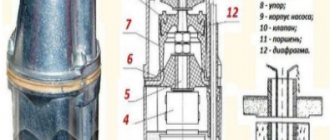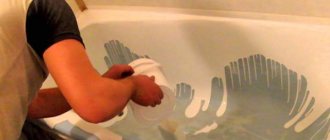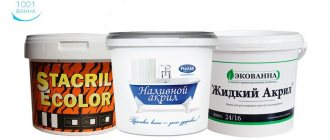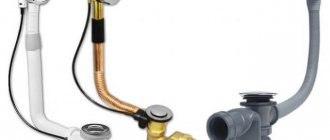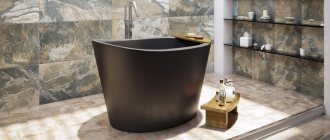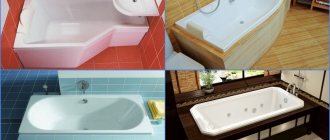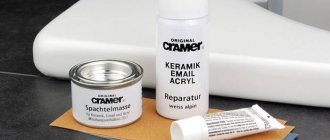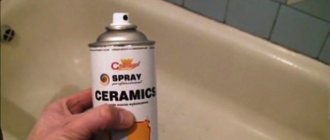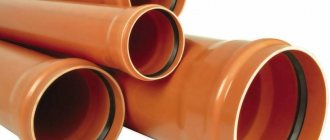Do you need hydromassage in the bath?
A hydromassage bath is a bath in which thin streams of water are supplied through holes (nozzles) in the body under pressure (up to 5 atmospheres). The first company to launch serial production of this equipment was the American Jacuzzi, the name of which subsequently became a household name and today denotes plumbing fixtures of this class, regardless of the manufacturer’s brand. The reason for the high demand for hydromassage baths is the healing effect they have on the human body:
- improves microcirculation of blood and lymph in superficial tissues, preventing their stagnation - this is especially true for people who lead an inactive lifestyle or are engaged in “sedentary” work;
- promotes relaxation of tense muscles, reduces physical fatigue and pain;
- supposedly helps eliminate cellulite, make the skin more elastic and emphasize the contours of the body by improving metabolism in the skin and the fatty tissue located underneath it;
- provides pleasant sensations, helping to relieve emotional tension, including during severe stress.
Although hydromassage baths are not certified medical equipment, their more advanced and specialized analogs are widely used in medical practice in the form of swimming pools installed in balneological resorts, sanatoriums, etc. It is worth considering, however, that the effect they have on the body is rather preventative rather than therapeutic. There is also debate in the professional scientific community about the degree of effectiveness of such equipment. However, owners of hot tubs often note a significant improvement in their well-being with regular use of water procedures.
In other words, the hydromassage function is an optional, but pleasant and to some extent useful addition. However, it significantly increases the price of the equipment, complicates its installation, maintenance and repair, which cannot be performed efficiently by a person who does not have the experience and knowledge to work with such systems. If these disadvantages, in your opinion, are not so significant and there are still more advantages from purchasing hydromassage baths, then you should go directly to the criteria for their selection.
Material
Let's start with the main characteristic, which significantly affects the durability, strength, convenience and aesthetics of bathtubs. The hydromassage function will not do any good if it is
the container will quickly lose its appearance, crack or be damaged in other ways. Currently, Jacuzzis are made from the following materials:
- Cast iron
. The classic option, the advantages of which are high mechanical strength, durability, low noise level and low thermal conductivity, which keeps the water heated longer. The disadvantages of cast iron bathtubs include their heavy weight, which makes transportation and installation difficult, as well as the enamel coating’s susceptibility to chips and cracks—after a few years, the equipment must be returned for restoration. - Steel
. The bodies of such hydromassage baths are stamped from steel sheet and covered with protective enamel. This makes the equipment quite light and at the same time durable, resistant even to strong impacts and falling heavy objects. There are, however, also disadvantages - first of all, high noise when filling the bath, high thermal conductivity, due to which the water cools down quite quickly, and enamel susceptibility to damage that cannot be repaired on your own. - Acrylic
. This is a lightweight and very durable thermoplastic, the plasticity of which allows you to create bathtubs of a wide variety of sizes and shapes. The positive aspects of acrylic models are their low weight, which makes them easier to carry and install, low thermal conductivity of the body, hygiene and ease of cleaning from any contaminants, resistance to the corrosive effects of water and cleaning agents. The disadvantage of plastic bathtubs is their lower strength (compared to cast iron and steel) - scratches, chips and cracks may appear on the body from falling heavy objects or strong accidental impacts (for example, when carrying). This problem has been partially eliminated in models made from quaril - a mixture of acrylic with mineral chips. In addition, if minor damage appears on the surface of acrylic bathtubs, they can be “cured” using a standard repair kit.
Currently, the most common option is hydromassage bathtubs made of acrylic - this is due to the optimal balance of reliability, practicality, price, and variety of design. However, it must be borne in mind that cheap models made of low-grade plastic are often sold under their guise, whose characteristics are much lower and the health hazard is higher. This is due to the presence of toxic components in their composition, which are especially intensely released when heated. You can learn how to choose the right acrylic bathtub (with or without hydromassage) from our other article.
Form
At first glance, it may seem that the shape of the bowl is a purely decorative criterion, but in practice it greatly influences the quality of use of the bathroom in general and the hydromassage system in particular. There will be no benefit from the latter if a person takes an uncomfortable position during washing, in which he cannot achieve complete relaxation. Depending on the model, the shape of the bowl is:
- Rectangular
. Such bathtubs are easy to make, easily fit into the layout of the room, but are not the most comfortable for humans, especially if their corners are sharp and not rounded. At the same time, they provide a person with a semi-recumbent position, in which the load on the spine is reduced. - Oval
. As with rectangular models, these bathtubs allow you to wash while reclining. The absence of sharp corners also increases the comfort of bathing. This form is one of the most common. - Round
. Depending on the size of the bowl, a person can wash in such a bathtub, reclining or sitting. Round models are difficult to “attach” to a wall or in a corner, so they are installed mainly in the central part of the room. Because of this, they are mainly equipped in spacious rooms. However, there are also compact models in which the round bowl is inscribed in a rectangular, trapezoidal or sectoral body - they are designed for corner mounting. - Semicircular
. The bowl of such baths is a part of a circle, limited on one side by a straight wall. This allows you to install them near a wall, but you can only wash in them while sitting. - Figured
. This category includes bathtubs in the form of an irregular trapezoid, a polygon, a distorted circle, etc. Depending on the model, they provide different levels of comfort; often this form has a purely aesthetic meaning and negatively affects the user’s comfort.
Many hot tubs have additional ledges that serve as support for the arms, head, back, or as seats. This improves the ergonomics of the plumbing fixtures, reducing the load on individual parts of the body that occupy an awkward position in standard-shaped models. Such equipment is recommended for people who have problems with the musculoskeletal system - for example, those suffering from chondrosis of the cervical or spinal vertebrae.
Type of hydromassage system
The effect on the human body in bathtubs with a hydromassage function is carried out in several ways:
- Air
. Such systems pump air into the water, which forms small bubbles that act on the skin. Air hydromassage is the simplest (and least expensive) to perform, does not consume water, and its effect is gentle. Additional stimulation of the soft tissues of the body is carried out due to cavitation (collapse) of bubbles. - Vodyany
. In this case, body massage is carried out with water jets supplied under pressure (up to 5 atm). This provides more intense stimulation of the skin and underlying tissues. At the same time, such systems cost more and increase water consumption, making them less economical. - Ultrasonic
. Systems of this type impact the user's body with high-frequency sound waves that have great penetrating power. Ultrasonic hydromassage is an innovative technology and is rarely used in home baths; its main area of use is medicine.
There are also hydromassage baths in which these methods of treatment are combined with each other. This ensures their greatest efficiency and the ability to select a separate mode depending on the user’s well-being. For example, air massage is used mainly for relaxation and pleasant sensations, while for deep tissue stimulation and a pronounced therapeutic effect, it is recommended to use water or ultrasound.
Number and location of nozzles
The number and position of whirlpool system outlets vary depending on the specific bathtub model. The greatest healing effect is achieved if the nozzles correspond to the anatomy of the human body:
- the holes for massaging the legs are located along the axial line and affect the feet, where a large number of nerve endings are concentrated;
- back jets are located at the lowest point of the bath - so they act on the entire back surface of the body;
- massage of the back and hips is carried out with nozzles located on the side walls.
With this arrangement of outlet holes, the impact is carried out on the most problematic and sensitive areas of the human body. At the same time, some less significant areas are not taken into account, which often reduces the effectiveness of the procedure. In this case, their massage is ensured by changing the position of the body - for example, to influence the inner side of the thigh, you can put one leg on the side of the bathtub, for which some models have a special protrusion-stand.
Additional functions
In addition to the hydromassage itself, bathtub manufacturers often equip their equipment with options designed to enhance the beneficial effect on the user’s body or entertain him during the session. These functions include:
- color therapy
- the effect on the emotional and (presumably) physical state of the user with illumination of various shades; - aromatherapy
- consists of improving the mental state with various pleasant odors through essential oils and other aromatic substances; - multimedia
- some models of hot tubs are equipped with built-in or removable TV, radio, video player, audio system to entertain the user during a long swim; - remote control
- provides control over the operation of the hydromassage system using a wireless remote control; - heating
- a heating element installed in the bathtub maintains a high water temperature, eliminating the need to periodically add water from the mixer.
However, there are well-founded doubts about the appropriateness of some of these options. For example, the effectiveness of color and aromatherapy has no scientific evidence; among representatives of official (evidence-based) medicine, these areas have a reputation as marginal. Moreover, their presence significantly increases the price of the equipment.
Installation of hydromassage baths
Installing a Jacuzzi is much more complicated than conventional bathtubs due to the presence of additional elements that supply water and/or air through the nozzles. Installation of this plumbing is carried out in several stages:
- Preparatory
. At this stage, the location of the bathtub in the room is marked, the base is leveled, the room is hydro- and vapor-proofed, and auxiliary elements are installed - in particular, a pressure reducer for the water supply pipes and a filter for water purification. This equipment will protect the hydromassage system from premature wear due to hydrodynamic shocks and exposure to impurities. You need to choose a location for the bath in such a way that it is close to the water pipes and provides easy access to all engineering systems to facilitate subsequent maintenance and repairs. - Bath installation
. The container itself is installed like a standard bathtub - for this, the included support legs or a supporting metal frame are used. By adjusting their height, you need to achieve a stable position of the body. Simultaneously with the bowl, a hydraulic and/or aero pump is attached to the support frame, depending on which system is implemented in a particular model. - Connection to engineering systems
. Installing the siphon and connecting it to the drainage system is carried out similarly to standard bathtubs without hydromassage. In this case, the drain pipe should be located 10 cm above the sewer socket - this will prevent water from stagnating or slowly draining from the bowl. At this stage, the mixer is connected to the water supply system, as well as the connection of pumps with nozzles with flexible or rigid pipes. - Connection to the electrical system
. For normal operation of the hot tub, an automatic cut-off switch must be provided in the apartment’s electrical supply system to prevent damage to electrical equipment during power surges. Next, the electrical components are connected to the distribution panel using a three-wire cable (neutral, phase and ground). The wires are twisted and soldered, then the junction is wrapped with electrical tape and impregnated with “liquid rubber”. All work on connecting to the electrical system must be performed only after it has been completely de-energized. - The final stage
. At the final stage, all joints of the bathtub and walls, joints of pipes and wiring are sealed. For this purpose, sealants, plastic and ceramic borders, protective boxes and other insulating materials are used. To prevent engineering systems from spoiling the appearance of the room, they are covered with a decorative plastic screen, which is hung on the side of the bathtub.
Obviously, installing a hot tub requires specialized skills and knowledge, especially when working with electrical equipment. Therefore, for reliability and safety, you should still entrust this work to specialist plumbers. Although you will have to pay extra for this, the equipment will last longer, and you will not have to worry about yourself and your loved ones every time you bathe.
Jacuzzi care
Cleaning a hot tub is strategically important, but not extremely difficult. Cleaning consists of the following steps:
- Fill the bath with water 15 cm above the nozzles.
- Turn off the air supply.
- Add detergent and bleach.
- Turn on the hydromassage for ten minutes.
- Drain the water and then start the process again using cold water.
Taking into account all the pros and cons regarding the Jacuzzi, we can conclude: such a device is beneficial, health, youth, mood.
Hot tub maintenance
Given the increased complexity of this plumbing fixture, more stringent requirements are also imposed on its care. The specifics of its maintenance depend on the material from which it is made, the type of hydromassage system, the composition of the water consumed and other factors. In general, the following procedures should be performed regularly to maintain proper operation of this equipment.
Cleaning the bowl
. When used, various contaminants remain on the surface of the bathtub - lime, rust, pipe sediment, grease, etc. To prevent the development and proliferation of bacteria, as well as to preserve the appearance of the plumbing, they must be removed using a soft cloth or sponge soaked in a cleaning agent . When choosing the latter, pay attention to the material of the bath:
- acrylic models cannot be cleaned using products containing acids, organic solvents, acetone or formaldehyde, as well as abrasive particles - they react with plastic, destroying it;
- Metal enameled bathtubs can be cleaned with powder and acid-containing products, but it is better to limit their use to difficult-to-remove stains and mainly use mild gel-based chemicals.
In both cases, it is necessary to exclude the use of metal brushes and sponges, rags, and napkins with coarse fiber. They cause micro-scratches to appear on the surface of bathtubs, in which dirt accumulates and bacteria develop.
Cleaning the whirlpool system
. The water used for bathing contains a large amount of impurities, which are gradually deposited in the tank, pipes and nozzles. They are cleaned in two ways:
- chemical - the system is washed with a weak solution of citric, acetic acid or a specialized cleaning agent;
- mechanical - involves dismantling the elements (nozzles and pipes) of the hydromassage system and then cleaning them using a specialized tool.
The user can perform chemical cleaning independently, but it is effective only if the hydromassage system is not highly clogged. If significant deposits of impurities have accumulated in the pipes and nozzles, they will need to be dismantled - to perform such work, it is better to contact plumbing specialists with the appropriate qualifications and experience. You can avoid severe clogging of the elements of the hydromassage system by regularly carrying out preventive cleaning with a weak solution of household acid (acetic, citric) or a specialized product.
Rules for using the hot tub
The hydromassage function is perceived by many of their owners as a pleasant addition with some healing effects on the body. However, to truly use this equipment effectively, you need to follow a few simple rules:
- It is necessary to separate the actual hydromassage session and bathing using foaming compounds, bath salts, essential oils, etc. These substances form a sediment that accumulates in the nozzles and pipelines, causing them to quickly become dirty;
- It is recommended to take hydromassage procedures for a measured time - no more than 20 minutes, and the hotter the water, the shorter the session should be.
- The water temperature recommended by physiotherapists is 35-38 degrees Celsius.
- The standard pressure under which water jets are supplied from the nozzles is 4-5 atmospheres. Any bath provides the ability to adjust the intensity of the effect - this may be necessary if you need to increase or decrease the therapeutic effect.
- Before the session, it is not recommended to eat heavily or drink alcohol - this disrupts metabolic processes in the body. After the procedure, you should avoid heavy physical activity; it is better to rest for a while in a calm position.
- Avoid complete immersion under water during the session - water jets or air bubbles can damage your eyes and eardrums.
Hydromassage procedures also have their own contraindications, including those that completely exclude them. These include skin diseases, acute infections, fever, oncological pathologies, urolithiasis, ischemia of the heart and blood vessels. This is due to the fact that the effect on soft tissue stimulates blood flow and other metabolic processes, which potentially increases the likelihood of exacerbation of the painful condition. Therefore, before purchasing a hot tub, you should undergo a medical examination and consult a physiotherapist to eliminate these risks.
Shapes and sizes
Where to start if you already know which Jacuzzi material will suit you best? Naturally, from the characteristics of your bathroom. What would be better: a small hip bath or a huge one that looks like a swimming pool? Rectangular, round or corner? The choice depends not only on the cost of the model, but also on how well the Jacuzzi system will fit into the interior of the bathroom, and whether it will be too cumbersome.
- Rectangular massage bathtubs are available in seated and
recumbent position. Thanks to its compact shape, the product can be successfully placed even in a five-meter bathroom. - Corner baths for hydromassage. A thoughtful combination of economical use of space and comfort. Sizes can be selected at your own discretion. Often they buy corner containers measuring 1.4 m by 1.8 m and 0.6 m deep.
- Round baths. A beautiful, original system, but demanding on space: it occupies a large area and is ineffective in small-sized housing.
- A certain subtype of jacuzzi is a hydromassage box - a box that combines the options of a hydromassage bathtub and a shower stall.
[sc:vtexteads]
